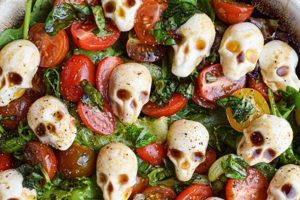Fresh, vibrant combinations of leafy greens, vegetables, and aromatic herbs create flavorful and nutritious meals. For example, a simple mix of baby spinach, chopped tomatoes, cucumbers, and a blend of parsley, mint, and dill, tossed with a light vinaigrette, offers a refreshing and healthy dish. Numerous variations exist, incorporating diverse ingredients like fruits, nuts, cheeses, and proteins, allowing for customized flavor profiles and nutritional value.
These culinary creations offer significant health advantages, providing essential vitamins, minerals, and antioxidants. Historically, the use of herbs in food preparation dates back centuries, adding flavor and medicinal properties to meals. The incorporation of fresh produce and herbs contributes to a balanced diet, promoting overall well-being and potentially reducing the risk of chronic diseases.
This exploration will delve into various aspects of creating these flavorful dishes, including selecting appropriate herbs, balancing flavor profiles, and understanding nutritional benefits. Further discussion will cover diverse recipe ideas and practical tips for preparation and presentation.
Tips for Herb-Infused Salads
Creating flavorful and nutritious salads enhanced with fresh herbs involves careful selection, preparation, and balancing of ingredients. The following tips offer guidance for maximizing flavor and achieving optimal results.
Tip 1: Herb Selection: Choose herbs based on desired flavor profiles and compatibility with other ingredients. Delicate herbs like dill, parsley, and chives pair well with lighter vegetables and vinaigrettes. More robust herbs, such as rosemary, thyme, and oregano, complement heartier salads and roasted vegetables.
Tip 2: Freshness is Key: Use fresh, high-quality herbs for the best flavor and aroma. Store herbs properly to maintain their freshness.
Tip 3: Proper Washing and Drying: Gently wash herbs and thoroughly dry them before chopping to prevent wilting and ensure even distribution in the salad.
Tip 4: Chopping Techniques: Finely chop herbs to release their flavors and prevent overpowering the other ingredients. Larger leaves can be torn or chiffonade.
Tip 5: Balancing Flavors: Combine herbs thoughtfully, considering their individual flavors and how they interact. Start with small amounts and adjust according to taste preferences.
Tip 6: Timing is Crucial: Add delicate herbs towards the end of preparation to prevent bruising and loss of flavor. More robust herbs can be added earlier.
Tip 7: Dressing Considerations: Select or create a dressing that complements the herbs and other ingredients. Light vinaigrettes often work well, allowing the herb flavors to shine.
By following these guidelines, one can elevate simple salads to flavorful and nutritious culinary experiences. Thoughtful herb selection and proper preparation techniques are essential for achieving optimal results and maximizing the health benefits of fresh, herb-infused salads.
The following section will present a collection of diverse recipes showcasing the versatility and delicious possibilities of incorporating fresh herbs into salads.
1. Fresh, Seasonal Ingredients
Fresh, seasonal ingredients form the foundation of exceptional herb-infused salads. Seasonality directly impacts the flavor and nutritional value of produce. Peak-season vegetables and herbs offer optimal taste and nutrient density. Utilizing ingredients at their peak ripeness enhances the overall salad experience. For instance, a summer salad featuring locally sourced tomatoes and basil offers a burst of flavor unmatched by out-of-season counterparts. This connection between seasonality and quality underscores the importance of selecting ingredients thoughtfully.
The availability of fresh, seasonal produce influences recipe development. Summer salads often showcase vibrant, delicate herbs like dill and mint, paired with juicy tomatoes and cucumbers. Conversely, fall and winter salads may incorporate heartier greens like kale and chard, complemented by robust herbs such as rosemary and thyme. Adapting recipes to seasonal availability ensures optimal flavor combinations and maximizes the nutritional benefits derived from fresh produce. This adaptability also fosters culinary creativity and encourages exploration of diverse flavor profiles throughout the year.
Prioritizing fresh, seasonal ingredients yields significant benefits. Enhanced flavor and nutritional value contribute to a more satisfying and healthful culinary experience. Supporting local agriculture promotes sustainable food systems and reduces environmental impact. Understanding the integral role of fresh, seasonal ingredients in crafting exceptional herb-infused salads empowers informed choices, leading to more flavorful, nutritious, and environmentally conscious culinary practices.
2. Variety of Herbs
The incorporation of a variety of herbs elevates salads from simple to complex culinary creations. Strategic herb combinations contribute depth of flavor, aroma, and visual appeal. Understanding the diverse characteristics of different herbs allows for tailored flavor profiles and enhanced nutritional value. This exploration delves into the multifaceted role of herbs in salad preparation.
- Flavor Dimensions
Herbs offer a wide spectrum of flavors, from bright and citrusy to earthy and savory. Dill, for example, imparts a light, anise-like flavor, while rosemary provides a more pungent, piney note. Blending different herbs creates complex flavor profiles, transforming a basic salad into a multi-sensory experience. The careful selection and combination of herbs contribute significantly to the overall taste and enjoyment of the dish.
- Aromatic Enhancement
The aromatic qualities of herbs play a crucial role in enhancing the sensory experience of a salad. Mint, with its refreshing and cooling aroma, complements sweeter ingredients like berries and fruits. Basil, on the other hand, provides a sweet, peppery aroma that pairs well with tomatoes and mozzarella. The interplay of aromas creates a more engaging and satisfying culinary experience.
- Visual Interest
Varying colors and textures of herbs contribute visual appeal. Parsley’s bright green adds vibrancy, while chives offer a delicate, slender texture. Incorporating a variety of herbs not only enhances flavor but also creates a visually appealing presentation. The thoughtful use of herbs elevates the salad from a simple dish to a work of culinary art.
- Nutritional Benefits
Different herbs offer unique nutritional profiles, contributing to the overall health benefits of the salad. Parsley is a good source of Vitamin K, while cilantro provides antioxidants. Incorporating a variety of herbs maximizes the nutritional value of the salad, contributing to a more healthful and balanced meal. Understanding the nutritional properties of different herbs allows for conscious choices that support dietary needs and promote overall well-being.
The strategic use of a variety of herbs significantly impacts the overall quality and enjoyment of a salad. By considering flavor dimensions, aromatic qualities, visual appeal, and nutritional benefits, one can create well-balanced, flavorful, and visually appealing salads that contribute to a healthful and satisfying culinary experience.
3. Balanced Flavor Profiles
Balanced flavor profiles are essential for creating flavorful and harmonious salads. The strategic combination of ingredients, including herbs, dressings, and other components, determines the overall taste experience. A well-balanced salad avoids extremes, offering a nuanced interplay of flavors that complement and enhance one another. This exploration delves into the key facets of achieving balanced flavor profiles in salads.
- The interplay of sweet, sour, salty, and bitter
A balanced salad incorporates a variety of tastes. Sweetness can come from fruits or roasted vegetables, sourness from citrus or vinegar, saltiness from cheese or olives, and bitterness from greens like arugula or radicchio. For example, a salad with strawberries, feta cheese, balsamic vinaigrette, and arugula balances these four elements. Careful consideration of these taste components ensures a complex and satisfying flavor profile.
- The role of herbs in balancing flavors
Herbs play a crucial role in balancing and enhancing flavors. They can add brightness, complexity, and depth to a salad. For example, mint can balance the richness of a creamy dressing, while dill can complement the subtle flavors of fish. The judicious use of herbs contributes significantly to the overall balance and harmony of the salad.
- The impact of dressings on flavor balance
Dressings contribute significantly to the overall flavor profile of a salad. A vinaigrette with a balance of oil and acidity can complement the other ingredients without overpowering them. For example, a lemon vinaigrette can brighten a salad with roasted vegetables, while a creamy dressing can complement a salad with fresh berries. The choice of dressing should harmonize with the other flavors present in the salad.
- Texture and its contribution to balance
Texture plays a significant, though often overlooked, role in flavor balance. A variety of textures adds interest and complexity to the salad. Crunchy nuts, creamy avocado, and crisp lettuce create a more engaging sensory experience. The interplay of textures enhances the overall enjoyment and contributes to a more balanced and satisfying salad.
Achieving a balanced flavor profile in a salad involves careful consideration of various elements. The interplay of tastes, the strategic use of herbs, the choice of dressing, and the incorporation of varied textures all contribute to the overall harmony and enjoyment of the dish. A well-balanced salad offers a complex and satisfying culinary experience, showcasing the nuanced interplay of flavors and textures.
4. Nutritional Value
Nutritional value represents a cornerstone of dishes featuring fresh greens and aromatic herbs. These culinary creations offer significant health benefits derived from the inherent properties of their components. Vitamins, minerals, antioxidants, and dietary fiber contribute to overall well-being and potentially reduce the risk of chronic diseases. For instance, leafy greens like spinach and kale provide vitamins A and C, while herbs such as parsley and cilantro offer antioxidants. The synergistic combination of these nutrient-rich ingredients creates a powerhouse of nutritional value, promoting optimal health.
The nutritional profile of these recipes can be further enhanced through the strategic selection of additional ingredients. Incorporating protein sources like grilled chicken or fish, along with healthy fats from avocados or nuts, creates a balanced and complete meal. This combination of macronutrients and micronutrients contributes to satiety, sustained energy levels, and overall nutritional adequacy. Furthermore, the variety of textures and flavors offered by these diverse ingredients enhances the culinary experience while maximizing health benefits. For example, adding roasted chickpeas to a salad provides protein and fiber, while a sprinkle of sunflower seeds adds healthy fats and vitamin E.
Understanding the nutritional composition of these recipes empowers informed dietary choices. Awareness of the vitamin, mineral, and antioxidant content allows for customization to meet individual dietary needs and health goals. This knowledge translates into practical applications, enabling the creation of meals that support specific health concerns or address nutrient deficiencies. Ultimately, incorporating nutrient-rich salads into one’s diet contributes to a holistic approach to health and well-being, promoting long-term health benefits through mindful dietary practices.
5. Creative Presentation
Creative presentation elevates salads with herbs from simple meals to visually appealing culinary experiences. Thoughtful arrangements and garnishes enhance the sensory appeal, encouraging enjoyment and appreciation. Visual appeal stimulates appetite and contributes to a more satisfying dining experience. For instance, arranging a salad with concentric circles of different colored vegetables and herbs creates a visually striking presentation. Similarly, garnishing a salad with edible flowers adds an element of elegance and sophistication. The impact of visual presentation extends beyond aesthetics, influencing perceived flavor and overall satisfaction.
Several techniques contribute to visually appealing salads. The choice of serving dish plays a significant role; a shallow bowl or platter showcases the arrangement effectively. Color plays a crucial role; incorporating a variety of colorful vegetables and herbs creates visual interest. Height and texture add another dimension; layering ingredients and incorporating elements like croutons or nuts provides textural contrast. Strategic placement of herbs as garnishes adds a final touch of visual flair. For example, a Caprese salad with concentric circles of tomatoes, mozzarella, and basil, drizzled with balsamic glaze, exemplifies effective use of color and arrangement. Practical application of these techniques enhances the dining experience, transforming a simple salad into a visually captivating culinary creation.
Effective presentation requires consideration of the overall composition and balance of the salad. Overcrowding diminishes visual appeal; negative space allows individual elements to stand out. Harmony in color and texture contributes to a cohesive presentation. Understanding these principles enables the creation of visually balanced and aesthetically pleasing salads. This attention to detail elevates the dining experience, transforming a simple meal into a feast for the eyes. The practical significance of creative presentation lies in its ability to enhance enjoyment and appreciation, contributing to a more satisfying and memorable culinary experience.
6. Versatile Meal Options
Dishes centered around leafy greens and aromatic herbs offer remarkable versatility, adaptable to a wide range of meal occasions and dietary preferences. This adaptability stems from the inherent flexibility of salads, allowing for customization based on individual needs and culinary creativity. Exploring this versatility reveals the potential of these recipes to fulfill diverse culinary roles.
- Light Lunches and Starters
These recipes function exceptionally well as light lunches or starters. Their refreshing nature and relatively low caloric density make them ideal for midday meals or as a prelude to a more substantial main course. A simple salad with mixed greens, cherry tomatoes, cucumbers, and a light vinaigrette provides a refreshing and satisfying lunch option. As a starter, a smaller portion of a more complex salad, perhaps featuring grilled shrimp or goat cheese, can stimulate the palate without overwhelming the appetite.
- Substantial Main Courses
The addition of protein-rich ingredients transforms these dishes into satisfying main courses. Grilled chicken, fish, beans, lentils, or tofu elevate the nutritional value and satiety factor. A Nicoise salad with seared tuna, boiled eggs, olives, and potatoes exemplifies this concept. The incorporation of grains, such as quinoa or farro, further enhances the nutritional profile and contributes to a more substantial and complete meal.
- Adaptable Side Dishes
These recipes readily complement a wide range of main courses as versatile side dishes. Their fresh flavors and contrasting textures provide a counterpoint to richer, heavier dishes. A simple green salad with a lemon vinaigrette provides a refreshing accompaniment to grilled meats or roasted vegetables. The adaptability of these recipes allows for seamless integration into diverse culinary contexts.
- Customizable to Dietary Needs
The inherent flexibility of salads allows for easy customization to accommodate various dietary restrictions and preferences. Vegetarian, vegan, gluten-free, and other dietary needs can be readily addressed through ingredient selection and modification. A vegan salad might feature roasted tofu and a tahini dressing, while a gluten-free salad would avoid croutons or dressings containing gluten. This adaptability ensures inclusivity and allows individuals with specific dietary requirements to enjoy these versatile and nutritious meals.
The versatility of salads featuring leafy greens and aromatic herbs extends beyond their adaptability to different meal occasions. Their customizable nature allows for endless variations, incorporating diverse ingredients and flavors to suit individual preferences and dietary needs. This inherent flexibility positions these recipes as valuable components of a balanced and adaptable dietary approach, contributing to both culinary enjoyment and nutritional well-being.
Frequently Asked Questions
This section addresses common inquiries regarding the preparation and utilization of salads incorporating fresh herbs.
Question 1: How can one preserve the freshness of herbs for salads?
Proper storage is crucial for maintaining herb freshness. Storing herbs in airtight containers within the refrigerator extends their lifespan. Alternatively, wrapping herbs in slightly damp paper towels and placing them in a sealed bag helps retain moisture and prevents wilting. Proper storage techniques ensure optimal flavor and quality.
Question 2: What are effective methods for washing and drying herbs prior to incorporating them into salads?
Gentle rinsing under cool water effectively removes dirt and debris. Thorough drying is essential to prevent wilting and ensure even distribution within the salad. Using a salad spinner or gently patting herbs dry with a clean kitchen towel achieves optimal results. Proper washing and drying techniques maintain the integrity and quality of the herbs.
Question 3: How does one determine appropriate herb combinations for specific salad ingredients?
Flavor compatibility guides herb selection. Delicate herbs like dill and chives complement lighter vegetables and vinaigrettes. Robust herbs like rosemary and thyme enhance heartier salads and roasted vegetables. Understanding flavor profiles facilitates harmonious pairings.
Question 4: What are the optimal methods for chopping and preparing herbs for salads?
Finely chopping herbs maximizes flavor release and ensures even distribution. Larger leaves can be torn or chiffonade. Sharp knives maintain the integrity of the herbs, preventing bruising and preserving their visual appeal. Proper chopping techniques enhance both flavor and presentation.
Question 5: How can one avoid overpowering a salad with the flavor of herbs?
Start with small quantities of herbs and adjust according to taste preferences. Balancing herb flavors with other ingredients, such as dressings and vegetables, prevents overpowering the overall flavor profile. Gradual incorporation ensures a harmonious balance of flavors.
Question 6: How can one maximize the nutritional benefits of salads with herbs?
Selecting a variety of herbs and incorporating nutrient-rich vegetables enhances the overall nutritional value. Adding lean protein sources and healthy fats creates a balanced and complete meal. Understanding the nutritional profiles of different ingredients allows for informed choices that maximize health benefits.
Understanding these key aspects of preparation and utilization optimizes the culinary and nutritional value of salads incorporating fresh herbs.
The following section provides a collection of curated recipes demonstrating the versatility and flavor potential of herb-infused salads.
Conclusion
Exploration of salads incorporating fresh herbs reveals their significant culinary and nutritional potential. Careful selection of fresh, seasonal ingredients, combined with a variety of herbs and balanced flavor profiles, yields dishes offering both aesthetic appeal and health benefits. Understanding preparation techniques, such as proper washing, drying, and chopping of herbs, maximizes their flavor and visual impact. Creative presentation further enhances the dining experience, while the inherent versatility of salads allows for adaptation to diverse meal occasions and dietary preferences.
Culinary creations centered around fresh produce and aromatic herbs represent a valuable contribution to a balanced and healthful diet. Continued exploration of diverse flavor combinations and innovative presentation methods promises further enhancement of culinary experiences. The integration of these recipes into regular dietary practices offers a pathway to increased consumption of nutrient-rich foods, promoting overall well-being and potentially mitigating the risk of chronic diseases. Emphasis on fresh, seasonal ingredients further supports sustainable agricultural practices and fosters a deeper connection with the natural world.






